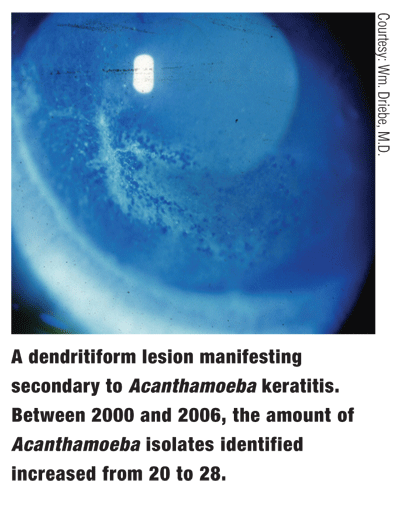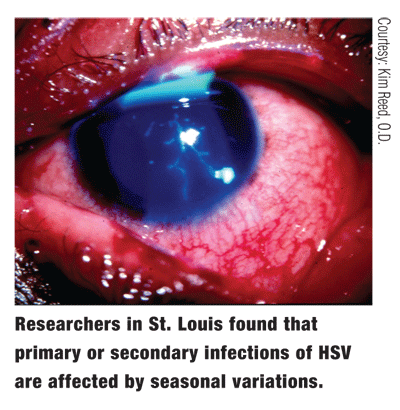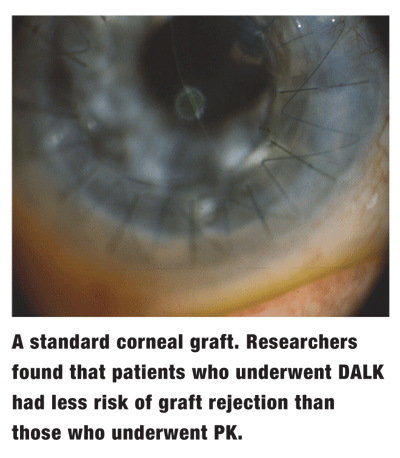This year, presentations in the cornea section run the gamut of microbial keratitis, contact lens solutions, herpes simplex virus, dry eye, penetrating keratoplasty and more. Much of this research has immediate and practical clinical application as well as potential for future studies.
Microbial Keratitis
This years presentations on microbial keratitis discussed trends in infection rates,756/B531 treatment strength,757/B532 and lens care techniques to prevent infection.781/B556 Geographic differences play a role in community-acquired  infections; and the resulting variables, such as differentiation and response to medication, depend on where one resides.
infections; and the resulting variables, such as differentiation and response to medication, depend on where one resides.
Besides an increase in both Acanthamoeba and fungal isolates over the past two years, the etiology of non-bacterial infectious corneal ulcers has not changed significantly in the past seven years, according to researchers in San Francisco.756/B531 Records of all cases presenting with corneal ulcers between 2000 and 2006 at the F.I. Proctor Foundation were reviewed to determine if the incidence of non-bacterial infectious corneal ulcers had increased during that time compared to a similar study that took place between 1976 and 1999. Herpetic ulcers were not examined.
Acanthamoeba isolates did not increase between the two studies; however, they increased from 1.8 per year from 2000 to 2004 to five per year in 2005 and 2006. Eight fungal isolates were found in 2006as many as in the previous five years all together. Between 1999 and 2006, the total number of bacterial, fungal and Acanthamoeba isolates identified had increased from 20 to 28. The researchers point to the recent sharp increase in Acanthamoeba isolates and recommend laboratory analysis as part of clinical management.
Since Acanthamoeba rates rose sharply over the last few years, make sure to consider this organism as part of your differential diagnosisespecially if pertinent data suggest such an infection in contact lens wearers. (Early signs and symptoms include pain disproportionate to clinical signs, cuffing of radial nerves, persistent epitheliopathy and bulls eye lesions.)
Researchers in the
fluoroquinolone used in treatment.
Researchers stress the importance of initial monotherapy and the use of an agent other than a fluoroquinolone to manage Gram-positive organisms. They found teicoplanin, penicillin G and cefuroxime most effective.
Before it comes to that, however, make sure to teach your patients proper contact lens care. If your patients use polyquaternium-1/myristamidopropyldimethylamine (PQ/MAPD)-based multipurpose solutions or polyhexamethylene biguanide (PHMB)-based multipurpose solutions, leaving the case open and allowing the solution to evaporate weakens its biocidal efficacy, say researchers in New York.781/B556
The PQ/MAPD-based solutions demonstrated significantly weakened efficacy against Staphylococcus aureus and Fusarium solani at four and six hours. Of the PHMB-based solutions, only two showed no reduction in biocidal efficacy with evaporation. Researchers warn that no MPS solution, fresh or used, should be left in an open case or other container.
HSV and HSK
Research presented this year dealing with herpes simplex virus (HSV) and herpetic stromal keratitis (HSK) will impact your management of patients. These findings will help you better care for patients with herpetic corneal infection.
Primary and secondary infections of the anterior segment in cases of HSV are affected by seasonal and temperature variations, researchers in St. Louis say.758/B533 A five-year review of records was conducted; cases were organized by which season the primary or secondary infection had occurred. Of the 33 patients analyzed (including 27 primary infections and 44 recurrences), 40.7% (11 cases) of all primary  infections occurred in either August or May; only 3.7% (1) of primary infections occurred during October, November and December. Of the 44 secondary infections, 34.1% (15) occurred in January and February, and another 18.2% (8) occurred during October, November and December.
infections occurred in either August or May; only 3.7% (1) of primary infections occurred during October, November and December. Of the 44 secondary infections, 34.1% (15) occurred in January and February, and another 18.2% (8) occurred during October, November and December.
HSK can be treated with topical cyclosporin A with a greater concentration than 0.1%, researchers in
After one week, the 0.1% and 1% cyclosporin A groups demonstrated decreased severity of HSK; this trend continued until day 14. Significant decreases in inflammation, stromal haze and T cells were also noted in the groups treated with 0.1% and 1% cyclosporin A. But, the groups treated with vehicle solution and 0.01% cyclosporin A showed no change.
Dry Eye
This years dry eye research points to new methods of treatment coming down the pipeline, as well as techniques for proper diagnosis. This information should help us better care for our patients afflicted with dry eye and blepharitis.
A mixture of 10 serum components drawn from selenocysteine, called selenoprotein (SeP), may be a viable candidate for the treatment of dry eye, say researchers in Japan.403/B605 Basing their hypothesis on the fact that autologous serums have met with success in cases of severe dry eye, they induced dry eye in a rat model and monitored the effects of SeP in one eye vs. the effects of phosphate-buffered saline (PBS) in the control eye through fluorescein staining.
The fluorescein staining score of the control eye was 7.6 3.6, while that of the SeP eye was lower: 2.4 2.2. But, the researchers note that the rats dry eye had been induced by removal of the lacrimal glands, which could have skewed the results.
Look for signs of meibomian gland dysfunction (MGD) to differentiate dry eye from chronic blepharitis, say researchers in the United Kingdom.412/B614 The study was intended to find the most useful test to differentiate between the two conditions; however, there were no significant differences in measurements of the tear film. In examining two groups of patientsone with chronic blepharitis and one with dry eye, researchers found that the only positive indicator was the patients MGD score. This score differentiated the two conditions with sensitivity of 79%, specificity of 69%, positive predictive value of 60% and negative predictive value of 85%. Overall, the patients MGD score correctly predicted the patients condition 62% of the time.
So, the tear physiology of patients with chronic blepharitis or dry eye will present with similar tear turnover rates, evaporation rates, structure, volume and osmolarity. But, their MGD scores, with a cut-off value of two dysfunctional glands, will predict blepharitis.
Corneal Grafts
Corneal graft rejections are common and can have devastating complications. Many variables impact graft success or failure, and several studies this year  explore some of the important predictors for success and methods by which rejection could be avoided.
explore some of the important predictors for success and methods by which rejection could be avoided.
Corneal graft rejection after penetrating keratoplasty (PK), if it occurs at all, is most common during the first year post-graft, researchers in the UK and Taiwan say.4674/B266 The researchers reviewed the case notes of patients at Manchester Royal Eye Hospital who had undergone PK between 2000 and 2003. Of the 229 eyes of these 207 patients, 44 episodes of graft rejection occurred in 37 patients. These patients had been indicated for PK because of keratoconus, a need for regrafts, postoperative corneal compromise, dystrophies or microbial keratitis. The mean time of rejection in these patients was 14.6 months, and some rejected grafts repeatedly or in both eyes.
Lamellar procedures have gained in popularity among corneal surgeons. In general, they allow for faster recovery with fewer complications when compared to penetrating keratoplasty. Patients who are indicated for deep anterior lamellar keratoplasty (DALK), however, can achieve visual function comparable to that achieved through penetrating keratoplasty (PK) without the risk of graft rejection, say researchers in Japan.4680/B672
They compared the records of equivalent groups of patients who had undergone DALK or PK and measured each patients subjective astigmatism, keratometry reading, corneal topography, spherical equivalent and best-spectacle-corrected visual acuity (VA). At 12 months, the DALK group had a mean subjective astigmatism of -2.91D, a spherical equivalent of -2.42D and a best-corrected VA of 0.62. The PK group had a mean subjective astigmatism of -2.88D, a spherical equivalent of -1.86D, and a best- corrected VA of 0.49. But, three eyes in the PK group experienced graft rejection. There were no complications in the DALK group.
Eyelid Health
This years research reminds eye-care practitioners not to forget a patients lid quality when diagnosing or managing any anterior segment condition. Managing lid disease helps to assure a more normal anterior segment stateespecially as patients age. Mite infestation, a common occurrence, may play a very significant role in lid inflammation.
The severity of lid margin disease corresponds positively with the patients age; in other words, the older the patient, the more severe the case of lid margin disease, say researchers in Boston.406/B608 They examined the lid margins and meibomian glands of 74 patients for gland alignment, lid hyperkeratinization, lid vascularity, gland secretion color, cross-sectional posterior lid margin and lash misdirection. All were found to have strong correlations to patient age, and all were chronically inflammatory.
Patients who demonstrate corneal manifestation of a Demodex infestation of the eyelids may find relief from their symptoms in weekly lid scrubs with a mixture of tea tree oil and tea tree shampoo, researchers in Florida say.3648 The six patients examined presented with ocular irritation and conjunctival inflammation; some of them also demonstrated meibomian gland dysfunction, symptoms of rosacea and decreased vision even though treatments of oral tetracycline, topical steroids and antibiotics had already been administered. Microscopic examination showed infestations of Demodex folliculorum (n=6) and Demodex brevis (n=3). Tea tree oil and shampoo scrubs for six weeks reduced Demodex counts from 6.8 2.8 to 1 0.9, and all patients showed resolution of ocular irritation and inflammation.
Researchers note that several corneal pathologies of rosacea, including conjunctival inflammation, present in a Demodex infestation and recommend that eye health practitioners turn to weekly lid scrubs with 50% tea tree oil and daily lid scrubs with tea tree shampoo for eradication of mites if conventional treatments fail.
Ocular Allergy
A patients skin and ocular allergies are closely related to each other, this years research demonstrates. But, much less of the allergen is required to affect the eyes. Skin responses provide predictive value and reflect the systemic nature of allergic disease; therefore, they have value in measuring ocular sensitivity responses to specific allergens.
Researchers in Boston determined that, in a conjunctival allergen challenge (CAC) study, the likelihood of candidates ocular reaction to an allergen could be determined by their skin reaction to the same allergen.2297/B995 The CAC model is the gold standard in comparing ocular allergy treatments, and the 306 subjects that participated in two CAC studies also underwent a skin-prick test with ten allergen extracts.
Positive results were indicated by size of the wheal and flare at skin-prick site; those subjects with positive results were then bilaterally challenged with the allergen they reacted most strongly to. Positive ocular results were defined as redness scores > 2 in two of three vessel beds, and itching scores > 2 bilaterally. Researchers found a negative correlation between skin test results and qualifying allergen concentrations: the stronger the participants skin reaction, the weaker the necessary qualifying dose.
Dr. Shovlin is in group practice in
403/B605. Higuchi A, Okubo Y, Tsubota K. Selenoprotein is a new candidate for the treatment of dry eye.
406/B608. Workman DA, Ousler GW, Abelson MB. Age related differences in lid margin health.
412/B614. Tomlinson A, Khanal S, Mcfayden A, et al. Determination of the most effective tests in differentiating chronic blepharitis from dry eye.
756/B531. Sansanayudh W, Cevallos V, Ou J, et al. Trends in the etiology of infectious corneal ulcers at the F.I. Proctor Foundation from 1976 to 2006.
757/B532. Kaye SB, Tuft S, Neal T, et al. Microbial keratitis: MIC and clinical outcome.
758/B533. Lind JT, Hsu HY. Seasonal variation in primary and secondary herpes simplex virus infections.
781/B556. Adamus TL, Zhao F, Coffey MJ, et al. Concentrated multi-purpose contact lens solutions and biocidal efficacy.
2297/B995. Chaturvedi R, Gomes PJ, Welch D, et al. A retrospective analysis of the predictive value of skin tests used in subjects screened in the conjunctival allergen challenge model.
3648. Kheirkhah A, Casas V, Blanco G, et al. Corneal manifestations of ocular Demodex infestation.
4297/B733. You IC, Oh HJ, Kang IS, et al. Effect of topical cyclosporine A on herpetic stromal keratitis in a mouse model.
4674/B666. Hillarby M, Rahman I, Haider D, et al. Aetiology and incidence of rejection in penetrating keratoplasty.

